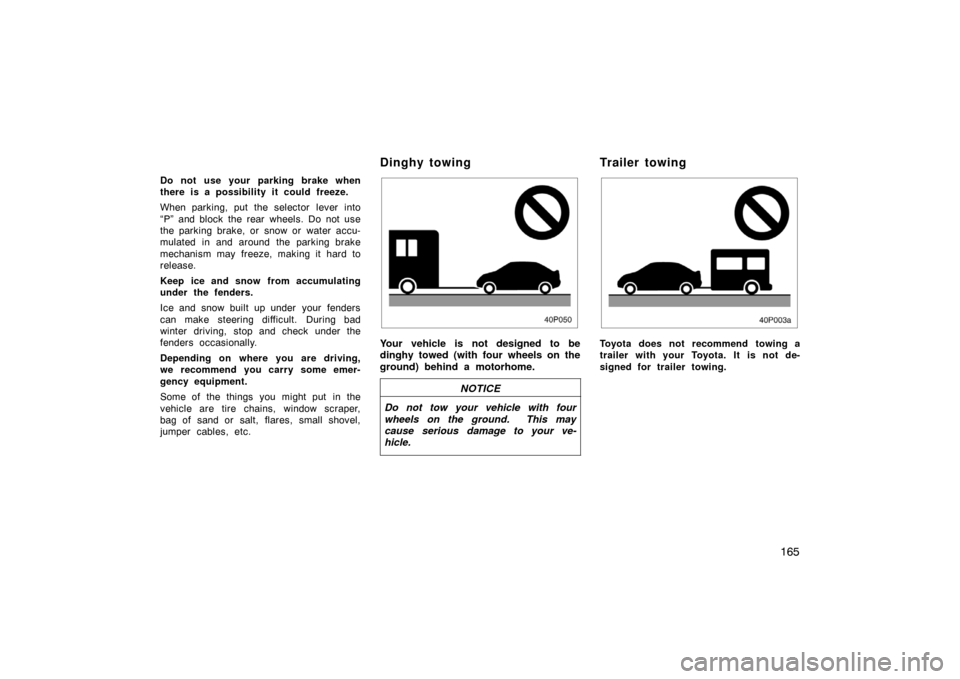Page 178 of 258

165
Do not use your parking brake when
there is a possibility it could freeze.
When parking, put the selector lever into
“P” and block the rear wheels. Do not use
the parking brake, or snow or water accu-
mulated in and around the parking brake
mechanism may freeze, making it hard to
release.
Keep ice and snow from accumulating
under the fenders.
Ice and snow built up under your fenders
can make steering difficult. During bad
winter driving, stop and check under the
fenders occasionally.
Depending on where you are driving,
we recommend you carry some emer-
gency equipment.
Some of the things you might put in the
vehicle are tire chains, window scraper,
bag of sand or salt, flares, small shovel,
jumper cables, etc.
40p050
Your vehicle is not designed to be
dinghy towed (with four wheels on the
ground) behind a motorhome.NOTICE
Do not tow your vehicle with four
wheels on the ground. This may
cause serious damage to your ve-
hicle.
40p003a
Toyota does not recommend towing a
trailer with your Toyota. It is not de-
signed for trailer towing.
Dinghy towing Trailer towing
Page 182 of 258

169
CAUTION
�Auxiliary battery and booster bat-
tery contain sulfuric acid which is
poisonous and corrosive. Wear pro-
tective safety glasses when jump
starting, and avoid spilling acid on
your skin, clothing, or vehicle.
�If you should accidentally get acid
on yourself or in your eyes, remove
any contaminated clothing and flush
the affected area with water for im-
mediately. Then get immediate med-
ical attention. If possible, continue
to apply water with a sponge or
cloth while en route to the medical
office.
�The gas normally produced by a
battery will explode if a flame or
spark is brought near. Use only
standardized jumper cables and do
not smoke or light a match while
jump starting.
�Warning: Battery posts, terminals and
related accessories contain lead and
lead compounds, chemicals known to
the State of California to cause can-
cer and reproductive harm. Wash
hands after handling.
NOTICE
The battery used for boosting must
be 12 V. Do not jump start unless you
are sure that the booster battery is
correct.
50p001b
JUMP STARTING PROCEDURE1. Put the selector lever in “P” and apply the parking brake.
2. Turn off the headlight switch and interi- or light.
3. Turn the ignition switch to “LOCK” and remove the key from the ignition
switch.
4. Open the trunk and remove the 3 clips at the left side of the trunk by pushing
the center with a screwdriver. Remove
the auxiliary battery cover.
Page 183 of 258

170
50p002
5. Remove the positive terminal cover ofthe auxiliary battery.
6. If the booster battery is installed in another vehicle, make sure the ve-
hicles are not touching. Turn off all
unnecessary lights and accessories.
7. If required, remove all the vent plugs from the booster batteries. Lay a cloth
over the open vents on the batteries.
(This helps reduce the explosion haz-
ard, personal injuries and burns.) 8. If the engine in the vehicle with the
booster battery is not running, start it
and let it run for a few minutes. During
jump starting, run the engine at about
2000 rpm with the accelerator pedal
lightly depressed.
50p044a
Discharged
battery
Booster
battery
Positive
terminal (“+” mark)
Jumper
cable Positive
terminal
(“+” mark)
9. Connect the jumper cables in the order a, b, c, d.
a. Connect the clamp of the positive(red) jumper cable to the positive
(+) terminal on the discharged bat-
tery.
b. Connect the clamp at the other end of the positive (red) jumper cable to
the positive (+) terminal on the
booster battery.
Page 184 of 258

171
50p045a
Booster
battery
Negative
terminal
(“−
” mark) Jumper
cable
Discharged battery
Positive
terminal
(“+” mark)
c. Connect the clamp of the negative (black) jumper cable to the negative
(–) terminal on the booster battery.
d. Connect the clamp at the other end of the negative (black) jumper cable
to a solid, stationary, unpainted, me-
tallic point of the vehicle with the
discharged battery.
The recommended connecting point is
shown in the following illustrations:
50p043a
Connecting point
CAUTION
When making the connections, to
avoid serious injury, do not lean over
the battery or accidentally let the
jumper cables or clamps touch any-
thing except the correct battery termi-
nals or the ground.
10. Start the hybrid system. Make sure the “READY” light is on. If the hybrid ve-
hicle battery warning light comes on in
the multi −information display, the hybrid
vehicle battery is also discharged. Con-
tact your Toyota dealer.
11. Carefully disconnect the cables in the exact reverse order: the negative cable
and then the positive cable.
12. Carefully dispose of the battery cover cloths—they may now contain sulfuric
acid.
13. If removed, replace all the battery vent plugs.
If the cause of your auxiliary battery dis-
charging is not apparent (for example,
lights left on), you should have it checked.